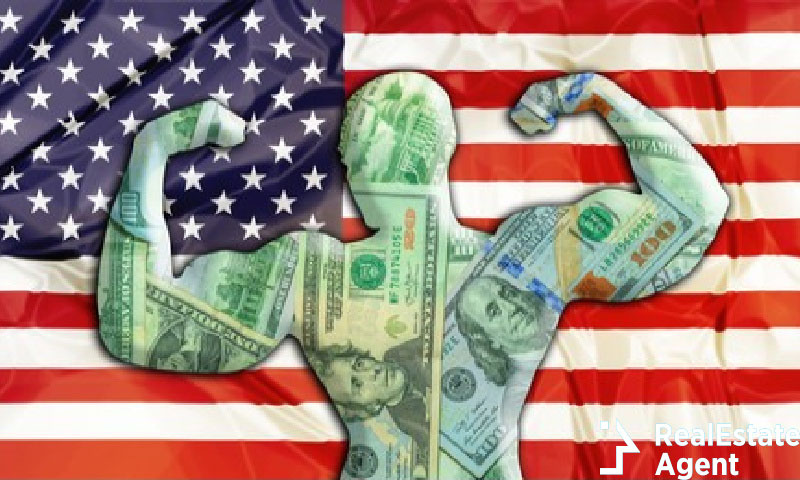Since the beginning of the year, the dollar has increased by 22% against the yen, 13% against the euro, and 6% against currencies from emerging markets, reaching its highest level since 2000. Given the dominance of the dollar in international trade and finance, a sharp strengthening of the dollar in a matter of months has significant macroeconomic implications for almost all nations.
There are several advantages and disadvantages to a strong dollar. It helps some people while impacting in a negative way others. The U.S. dollar’s ability to buy more foreign currency has increased due to its strengthening. It is regarded as strong when the dollar appreciates compared to other currencies on the foreign exchange market. While a strong dollar benefits americans traveling abroad, it disadvantages foreign tourists visiting the United States. There are benefits and drawbacks concerning areas of strength for a dollar, and how you see, it will rely upon the market, industry, and location. The top benefits and drawbacks of a strong dollar are listed below.
Pros of a strong dollar
- Americans who hold U.S. dollars can watch those dollars travel further abroad, giving them more purchasing power abroad. A strong dollar can buy more goods when converted to the local currency. That is because local prices in other countries are not affected by changes in the U.S. economy. U.S. residents living and working abroad will likewise see their cost for most everyday items decline on the off chance that they own dollars or get them as payment.
- If the manufacturer’s currency declines in value compared to the dollar, goods manufactured abroad and imported into the United States will cost less. The cost in dollars of European-made luxury automobiles would all decrease. The cost of imports will continue to fall as long as the dollar continues to rise. The price of other cheaper imports will also fall. This will give American consumers more money to spend on other things. Companies in the United States that bring in their own raw materials will be able to lower their production costs. They will also increase their profit margins.
- Investors and foreign businesses that do a lot of business in the United States will benefit. Gains in the dollar’s value which will be reflected on the balance sheets of multinational corporations with significant sales in the United States. These businesses’ investors ought to be rewarded as well.
- A strong dollar supports the dollar’s position as the world’s reserve currency. Although Russia, Iran, and China have questioned the U.S. dollar’s status as the de facto world reserve currency, a strong dollar helps maintain its high demand as a reserve currency.
Cons of a strong dollar
- With a stronger dollar, Americans’ prices for goods and services will rise for visitors from other countries. The cost of living will rise for business travelers. As well for foreigners living in the United States with foreign-denominated bank accounts or those paid in their home currency.
- The value of the income they receive from sales in other countries will decrease on their balancing sheets. Negatively impacting US-based businesses that do a significant part of their businesses internationally. Investors in such companies are likely to suffer as well.
- Unfamiliar states requiring US dollar stores will end up paying more to get those dollars. In emerging market economies, this is especially crucial.
- Domestically produced goods become more expensive abroad as imports become less expensive. For example, at a rate of 1.35 dollars to euro, a $30,000 American-made car would cost €22,222 in Europe. But, when the dollar strengthens to 1.12 euros per dollar, it rises to €26,786. It has been argued that high-priced exports may harm American employment.
In 2022, the US dollar’s value has increased significantly. Compared to the currencies of numerous other nations, including the euro, the Japanese yen, and the British pound. The pound is at its lowest level against the dollar since 1985, the yen is at its lowest point since 1998, and the euro was worth less than the dollar for the first time in 2022. The dollar is at its highest in 20 years against other major currencies. Although having a stronger dollar may sound like a good thing, being strong also has its drawbacks. In fact, the dollar’s value is now too high for its own good.
Why is the dollar so strong?
When stock and bond markets become volatile, as they have this year, many investors consider the dollar to be the safest asset to hold. That is part of the way because the dollar has an exciting status as the world’s “save cash.” This implies national banks and monetary establishments all over the planet hold bunches of dollars for global exchanges. They do this because it facilitates international lending and investing by using a single currency rather than having to convert between them.
The US economy is doing better than many other nations. The growth is slower, and debt and inflation are higher than in the US. Europe, in particular, is experiencing high inflation and sluggish growth. This is because of energy supply disruptions brought on by the war in Ukraine.
The markets’ perceptions of the policies implemented by various nations’ governments and central banks are also reflected in the dollar’s strength. The Federal Reserve is raising interest rates faster than other central banks to slow inflation. Meanwhile, the pound’s value against the dollar has fallen to its lowest level in decades due to a package of tax cuts announced by the UK. Which is struggling with high inflation and weak growth.
Is a strong dollar good or bad?
The most evident risk area of strength for postures is how it can hurt U.S. stocks. Many individuals depend on them as the backbones of their retirement accounts. When a company’s euro-denominated sales are converted into dollars, their value decreases. This indicates that a rise in the dollar value will likely impact these businesses’ profits, stock prices, and revenues. Besides harming income, a super-solid dollar can hurt U.S. stocks and bonds. They make them more costly for enormous non-U.S. institutional financial backers. They might decide to put their money elsewhere if prices increase, hurting U.S. markets.
Even though a strong dollar hurts stocks in the United States, it makes international stocks cheap for U.S. investors looking to diversify their portfolios. International reserves have performed better than U.S. stocks. They have tended not to rise or fall in tandem with U.S. markets/ An investor’s portfolio may experience less risk as a result of diversifying with non-U.S. stocks over time. The solid dollar helps the loads of non-U.S. organizations who work in monetary forms like the yen or euro but trade their items to the U.S. Supply chain problems will likely affect the price of goods made in other countries as much as currency values do. Most of the food and energy going up in price for households are made in the United States rather than imported. Imported goods are less expensive for U.S. consumers when the dollar is strong. That may help cushion some of the impacts of high inflation in the United States.
Is there an alternative?
The dollar will likely remain the global currency of choice for the foreseeable future. Dollars are still in high demand for international trade and transactions. Despite long-standing concerns about growing business and budget deficits in the United States. Most commodities, from oil to soybeans, are traded in U.S. dollars, and importers of those goods must hold dollars for trade purchases. About 40% of global financial transactions are settled in U.S. dollars. For upcoming transactions, exporters have funds in short-term U.S. Treasuries. The size and liquidity of the U.S. Treasury market provide a steady foundation for international trade and investment. These requirements cannot be met by any other currency than the dollar. The euro is used a lot in financial transactions. Its use has been limited by its fragmented bond markets and a long period of negative interest rates. Japan’s yield curve control and zero interest rate policies make it unattractive. Yet, it’s not even uninhibitedly convertible because of capital controls.
Conclusion
The dollar being so strong right now is not sustainable. One necessary condition for the end of the dollar rally is an absolute peak in the risk of inflation in the United States. This would slow down its aggressive tightening cycle. More factors would be required. Such as a peak in Europe’s energy uncertainty. A move away from zero COVID in China continues to disrupt supply chains and contribute to the global slowdown. In order to slow the unprecedented increase in safe-haven immigration into the United States, at least some of these must occur, but for that to happen, all these components need to come together.
Words like “strong” and “weak” can be misleading. People can believe that an appreciating currency is always better for the economy. Better than one that depreciates, but this is not true. There is no specific link between a nation’s economy and its currency’s strengths. But, everyone is affected by the dollar’s value concerning other currencies. All other things being equal, a stronger dollar makes it more expensive for foreigners to buy things made in the United States. This is good for Americans who buy foreign goods (imports) and bad for American exporters and companies that might not export but compete with imports. Additionally, American businesses that compete with imports and exporters of U.S. goods benefit from a weaker dollar because it makes foreign goods (also known as imports) somewhat more expensive for American consumers.











